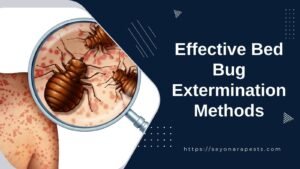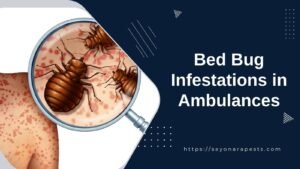Bed Bug Behavior
Understanding the behaviors of bed bugs is essential for homeowners, hoteliers, and anyone who may come into contact with these pests. This knowledge is key to effectively managing and preventing bed bug infestations.
Daytime Feeding Habits
Contrary to popular belief, bed bugs are not strictly nocturnal creatures. While they are most active at night, these insects can and will bite during the day if they are hungry and a host is available.
Bed bugs tend to seek out a host whenever they require a blood meal, regardless of the time of day. They may be emboldened to feed during daylight hours if they feel safe and undisturbed.
The possibility of daytime feeding suggests that vigilance should be maintained at all times, especially in environments where bed bugs are suspected. For those concerned about bed bug activity during travel, it’s advisable to learn how to check for bed bugs in hotel rooms.
Travel Patterns
Bed bugs are notorious for their hitchhiking abilities, but they do not travel on humans as one might think.
These pests avoid heat and are unlikely to be found on the skin or hair. Instead, they prefer to stow away in items such as backpacks, luggage, and shoes, making these objects prime targets for inspection, especially when traveling or returning home (Scientific American).
Knowing this, individuals can take steps to prevent bed bugs when traveling by carefully examining their belongings and employing protective measures such as luggage encasements or treating personal items with heat or steam, both effective ways to kill bed bugs.
By understanding the true nature of bed bug behavior, specifically their feeding habits and travel patterns, individuals can better protect themselves and their environments from the threat of infestation.
It’s imperative to approach bed bug control with accurate information, dispelling any common misconceptions about bed bugs that could hinder effective management and elimination efforts.
Common Misconceptions
When it comes to bed bugs, misinformation abounds. Homeowners, hoteliers, and renters alike often fall prey to myths that can hinder effective pest control. Here, we address common misconceptions about bed bugs, especially concerning disease transmission and their hiding spots.
Disease Transmission
One of the most persistent misconceptions about bed bugs is their role in disease transmission. Contrary to some beliefs, bed bugs are not vectors for diseases to humans.
While they can carry human pathogens, there have been no reported cases of bed bugs transmitting diseases to humans.
Scientific American confirms they do not spread diseases, although their bites can cause allergic reactions in some individuals.
Similarly, Camino de Santiago Forum and Smithereen reiterate that bed bug bites may lead to skin reactions but are not linked to medical illnesses.
| Myth | Fact |
|---|---|
| Bed bugs transmit diseases | Bed bugs do not transmit diseases to humans |
| Bed bug bites spread illness | Bites may cause allergic reactions but do not indicate disease spread |
Understanding the truth about bed bugs is crucial for effective pest management and avoiding unnecessary anxiety. For more detailed information, explore bed bug myths and facts.
Preferred Hiding Spots
Another common misconception revolves around the preferred hiding spots of bed bugs. It’s often thought that bed bugs reside only in beds or on fabric surfaces. However, bed bugs can survive for several months without feeding, which means they can be found in various places, not just where people sleep.
Bed bugs tend to avoid heat and are unlikely to travel on human bodies. They prefer to hitch a ride on items like backpacks, luggage, and shoes rather than sticking to skin or hair.
Scientific American suggests that while they can be found in beds due to feeding preferences, they are just as likely to infest other areas away from direct human contact.
To prevent and manage bed bug infestations, it’s important to consider their actual behavior and hiding spots.
Familiarizing oneself with the various environments that can harbor bed bugs is key, including in transport vehicles and accommodations. For further guidance, see our articles on preventing bed bugs when traveling and how to check for bed bugs in hotel rooms.
Effective Bed Bug Treatments
When faced with a bed bug infestation, homeowners and renters, as well as managers of hotels and Airbnbs, often seek the most effective methods to eradicate these persistent pests.
There are several treatments available, but not all are equally effective. Two of the most reliable treatments are fumigation and heat, and professional pest control services.
Fumigation and Heat Treatments
Fumigation involves sealing off the infested area and filling it with a pesticide gas that suffocates or poisons the bed bugs.
On the other hand, heat treatments raise the temperature of the affected space to a level that is lethal to bed bugs. Both methods require professional execution and have been proven to be very effective.
| Treatment Type | Average Cost | Efficacy | Safety |
|---|---|---|---|
| Fumigation | $2,000 – $3,000 | High | Professional use only |
| Heat Treatments | $2,000 – $3,000 | High | Professional use only |
According to Scientific American, heat treatments are among the best options, as bed bugs have shown resistance to chemical treatments. This method can be particularly effective for large-scale infestations and is often considered one of the safest and most effective approaches.
Individuals looking for killing bed bugs with heat can find comprehensive guides and professional recommendations on our internal pages.
Professional Pest Control
While there are numerous DIY methods available, they often fall short in completely eliminating bed bugs due to the insects’ hardiness and ability to hide.
Over-the-counter insecticides, pest-control bombs, and vacuuming might seem like cost-effective solutions, but they are often ineffective and can even worsen the infestation if not applied correctly.
Professional pest control operators are equipped with the knowledge, tools, and treatments to effectively manage bed bug infestations.
They may use a combination of methods, including heat treatment and chemical solutions, to ensure that the bed bugs are eradicated thoroughly.
Professionals can also provide guidance on preventing bed bugs from spreading and how to check for bed bugs in hotel rooms, which is especially beneficial for businesses like hotels and Airbnbs.
For those dealing with this issue, exploring professional bed bug treatment options can provide a deeper understanding of available solutions and point towards the best bed bug elimination techniques.
To ensure the safety and comfort of occupants, as well as the reputation of accommodations, it’s crucial to tackle bed bug problems with efficient and professional treatments. These methods not only offer a higher success rate but also reduce the risk of a recurring infestation.
Signs of Bed Bug Infestation
Identifying an infestation of bed bugs early can be the key to preventing a minor issue from becoming a major infestation. Homeowners, hoteliers, and renters alike must be vigilant. Here are signs that bed bugs have taken up residence.
Active Presence
Despite their nocturnal nature, bed bugs may be seen during the day, especially in severe infestations.
According to Scientific American, with a large population, bed bugs may move away from their typical hideouts, making daytime sightings more likely. This active presence can include:
- Live bugs, particularly around sleeping areas.
- Rust-colored spots on bedding or furniture from their droppings.
- Shed skins or eggshells in places where bed bugs hide.
- Small bloodstains on sheets or pillowcases.
It’s also worth noting that bed bugs adapt their feeding schedule to the sleeping patterns of their hosts. So, if you work nights and sleep during the day, bed bugs may adjust and become active when you’re in bed.
Odor Release
Bed bugs release alarm pheromones when disturbed, which can produce an odor. Some people compare the smell to coriander, while others describe it as unpleasant, especially at higher concentrations.
This scent is akin to the odor released by stink bugs and can be an indicator of an infestation. The intensity of the odor can correlate with the size of the infestation.
If you suspect bed bugs are sharing your space, it’s crucial to investigate further or consider professional pest control.
For more information on identifying and preventing bed bugs when traveling, or understanding what attracts bed bugs to your home, our website has a wealth of resources.
Should you find signs of bed bugs, explore effective bed bug extermination methods or professional bed bug treatment options to address the problem swiftly and effectively.
DIY Approaches
The battle against bed bugs often drives individuals to try various do-it-yourself methods. While the initiative to solve the problem is commendable, it’s important to understand the risks and effectiveness of DIY approaches when dealing with these persistent pests.
Risks and Ineffectiveness
Many homeowners and renters may turn to over-the-counter solutions or home remedies in an attempt to tackle bed bug infestations.
However, methods such as insecticides available at local stores, pest-control bombs, and even meticulous vacuuming carry significant risks and often fall short in terms of effectiveness.
Over-the-counter insecticides and pest-control bombs not only expose residents to potentially harmful chemicals but also may not reach the deep crevices where bed bugs hide.
Moreover, these pests are known for their resilience and can survive many forms of chemical treatments.
As a result, such DIY attempts can be dangerous and may only provide a temporary reduction in bed bug numbers, potentially allowing the infestation to grow unchecked.
Vacuuming, while a useful tool in the fight against bed bugs, is not a standalone solution. Bed bugs can easily evade this method by hiding in small cracks and within fabrics, making it impossible to remove them entirely without professional intervention.
According to experts, self-applied treatments rarely resolve a bed bug problem. In fact, not calling a professional promptly can lead to a worsening infestation, making eventual eradication more difficult and costly.
Professional Recommendations
For those dealing with a bed bug situation, professional pest control services are highly recommended. Specialists in this field have access to more effective tools and methods, such as fumigation and heat treatments, which have been shown to be among the safest and most successful strategies for bed bug eradication.
Traditional pesticides often prove ineffective due to the development of pesticide resistance among bed bug populations. In contrast, heat treatments target the bugs with high temperatures that they cannot tolerate, thereby eliminating them at all life stages, including eggs.
While professional bed bug treatments can be costly, with prices ranging from $2,000 to $3,000 for a single-family home, they offer a level of effectiveness that DIY methods cannot match.
Investing in professional services not only ensures the thorough removal of bed bugs but also saves time and avoids the potential risks associated with self-treatment.
For those interested in learning more about professional bed bug control methods, explore our comprehensive guide on professional bed bug treatment options.
And for additional information on natural and DIY bed bug remedies, check out our article on natural remedies for killing bed bugs, but always consider these as supplemental to professional extermination methods.
Prevention Tips
Preventing bed bug infestations is often easier than dealing with an active one. Careful inspection and regular cleaning can play a pivotal role in keeping these pests at bay.
For those concerned about bed bug invasions, these prevention strategies can be a first line of defense.
Inspection and Cleaning
Regular inspection and cleaning are critical in preventing bed bug infestations. Homeowners, renters, and those in the hospitality industry can take proactive steps to ensure their environments remain pest-free.
- Luggage Inspection: After traveling, inspect luggage and other travel items for signs of bed bugs. Use a flashlight to look into crevices and pockets.
- Washing Clothing: Wash all travel clothing in hot water and dry on the highest setting to kill any potential bed bugs.
- Vacuuming: Vacuum all areas of the home frequently, especially around beds and upholstered furniture. Dispose of the vacuum bag or clean the container outside immediately.
- Bedding Care: Wash and dry bedding regularly on the hottest temperature settings.
- Furniture Checks: Look for signs of bed bugs on mattresses, box springs, bed frames, and headboards. Don’t neglect hidden areas and folds where bed bugs can hide.
- Professional Help: If you suspect an infestation, don’t hesitate to seek professional bed bug treatment options.
For more detailed information on inspection methods, visit our guide on how to check for bed bugs in hotel rooms.
Professional Inspection and Treatment
In addition to personal vigilance, professional inspection and treatment can offer an extra layer of security against bed bugs.
- Regular Inspections: Schedule regular inspections with a pest control professional, especially if you operate a hotel or rental property.
- Treatment Options: If bed bugs are detected, professionals can provide various treatment options like killing bed bugs with heat, using steam, or applying insecticides for eradication.
- Preventive Measures: Professionals can also offer guidance on preventive measures tailored to your specific situation, such as encasements for mattresses and furniture.
- Education: Learn about common bed bug behaviors and misconceptions to stay informed. Our article on bed bug myths and facts can help debunk common misunderstandings.
Remember, early detection and immediate action are key to preventing bed bugs from spreading. By incorporating regular inspection and cleaning routines, along with professional services when necessary, you can maintain a bed bug-free environment.




